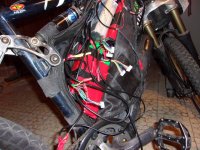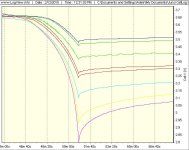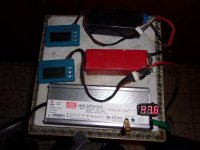I'm trying get a 48V build started while I was aware of the low-discharge concerns with LiPo....
Not sure what you mean here, actually, Lipo has high dis-charge rates. Now, I am switching to the new Multistar, which has a 1C discharge rate, the lowest of any Lipo. Still, icecube57 , a member here who does lots of testing, estimates a continuous discharge rate of 25 Amps. That's conservative I think, since there are a couple of guys over @ pedelecsuk running them at twice that.
I did not know of the LVC that most controllers have. The "alarms" comment got me reading up on Cell-log LVC/BMC. It would be folly IMHO to run a single, unified pack without a BMS or similar, that makes sense.
To run Lipo without a BMS, it's imperative to keep things simple(no more than 2P) and to have a fool-proof LVC.
That's why the 18650 shark pack I want to get is so svelte, and pricey.
Check out the Li-Ion batteries @ BMS Battery.
From what I've been reading it definitely takes more time and effort to balance and maintain 5S or 6S packs
Well, for a 48V build, one would use 6S bricks, 6S + 6S = 46V (nom.). 6S is no more easy or difficult to build and balance than any other configuration of <6S. It's when one goes to 7S, 8S or larger bricks that things get more complicated. That's because most balancing techniques only go up to 6S.
...a myriad of connectors, parallel balance boards, etc. It doesn't look as clean and pretty as a unified pack, but it gets the job done.
It's funny you should write this as I spent most of the day changing out my batteries and trying to clean things up a bit. Since everything is a bag, "cleaning up" is more like hiding things, but like "dirt under the carpet", I know what's in there and I keep trying. This is the 5th. major revision in 4 years, so I'm getting better at it every time;

12S/10Ah in the bag.
.

The other half of the battery and the frt. controller installed.

Rear controller in, done.
That's 2 medium sized 9-FET controllers and 20Ah of 12S in there, not bad :lol:
Used 9 pairs of 4 m/m bullet connector and a bag of 10 JST extension leads for this redo.
Made my own Y parallel adapter leads this time.
Every time I hold a brick of Lipo in my hands, I'm just amazed @ the amount of energy it contains for it's size.
To further summarise BMS vs. no BMS;
Is it easier to build a Lipo pack without a BMS? Yes.
Does not using a BMS save space? Yes.
Does it cost less to not use a BMS? No, I don't think so. I use Battery Medics, one for each brick, and a BM is around $15.
Is it safe to not use a BMS? Yes, if done correctly.
Will the batteries last as long without a BMS? Yes, if done correctly.
Does it take longer to charge without a BMS. Yes. At the beginning of the charge cycle, I clip on the BM's and read all the cell Voltages. At the end of the charge cycle, I again read the Voltages and if the cells are straying, I will bring them down in-line with the BM's. Usually they are ok, or just a little off and it doesn't take long to balance this way. But it is an extra step.
Bottom line;
Running Lipo like this is best viewed as a hobby, as it can be time consuming.
But if one likes maintaining one's batteries "hands-on", it can be a lot of fun.
Note on my new Multistar.
Right now, the cells are unruley and not wanting to play nice with their brethen. I have seen this before with new Lipo and expect as I add cycles(short ones for now), they will fall in lock-step.
My experience is such, that if the pack is left together, they "learn" to work together and there is less and less need to balance as the cycles go by.






